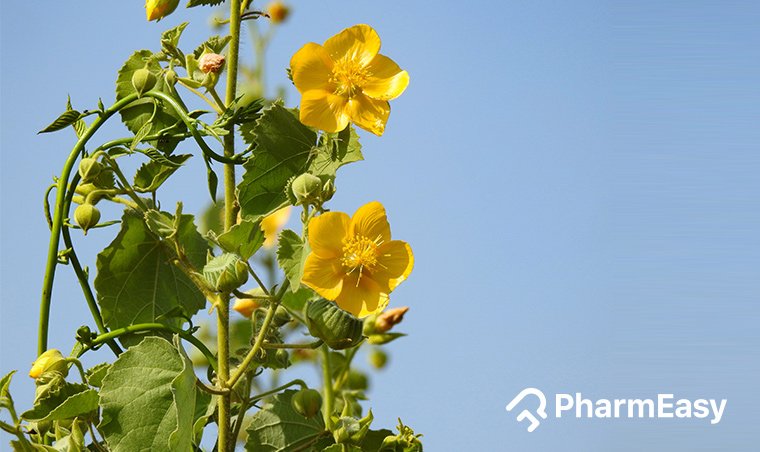Atibala: Benefits, Side Effects, Precautions & More
By Dr Siddharth Gupta +2 more

Get,

to manage your symptom
Get your,


4 Cr+ families
benefitted

OTP sent to 9988776655



You’ve successfully subscribed to receive
doctor-approved tips on
Whatsapp

Get ready to feel your best.

Hi There,
Download the PharmEasy App now!!


Register to Avail the Offer
Send OTPBy continuing, you agree with our Privacy Policy and Terms and Conditions

Hi There,
Sign up on PharmEasy now!!
Trusted by 4 crore+ families

OTP sent to 9988776655



You have unlocked 25% off on medicines




Code: NU25
By Dr Siddharth Gupta +2 more
Table of Contents
Atibala, scientifically called Abutilon Indicum (Linn.), belongs to the Malvaceae family. It is known as Country mallow in English, Kanghi in Hindi, and Atibala in Sanskrit. It’s a perennial shrub that grows up to 3 meters tall1.
The plant can be found in India, Sri Lanka, America’s tropical regions, and Malesia. It grows as a weed in sub-Himalayan areas, up to 1200 meters in elevation, and in hotter portions of India1.

Abutilon Indicum (Linn) also known as atibala is a medicinal plant used in our Traditional System of Medicine to address various health problems1.
Whole plant: Mucilaginous compounds, asparagines, saponins, flavonoids, and alkaloids are found throughout the plant.
Atibala contains various essential oils like α-pinene, caryophyllene, caryophyllene oxide, endesmol, farnesol, borenol, geraniol, geranyl acetate, elemene, and α-cineole2.
The Atibala plant has been used for its variety of medicinal properties since ancient times. It has shown positive effects on fever, allergy, bloody dysentery, etc. The Atibala tree’s bark is highly beneficial in tending to urinary complaints. Leaves of the Atibala tree work wonderfully on toothache, piles, and all kinds of inflammations.
Dr. Siddharth Gupta, B.A.M.S, M.D (Ayu)
In Unani medicine, the seeds of Atibala trees are used as a tonic and used for the management of bronchitis, chest troubles, piles, and gonorrhoea. The smoke of its seeds on charcoal is used to treat threadworms in children’s rectum. Similarly, its root has many health benefits and is used as a cooling medicine, laxative, pulmonary sedative, demulcent and diuretic.
Dr. Rajeev Singh, BAMS
Your doctor will prescribe you the appropriate form based on your individual needs.
Atibala is safe to use and shows no side effects or toxicity in humans6.
Also Read: Kutki: Uses, Benefits and Side Effects by Dr. Rajeev Singh
Also Read: 6 Ayurvedic Science-Backed Benefits Of Moringa!
The plant is known by various names in different languages as follows:
> Sanskrit name : Kotibala, Kankatika
> Hindi name : Kangahi, Kanghi, Kanghani
> English name : Country-mallow
> Telugu name : Tutiri-chettu, Thuteribenda
> Tamil name : Tutti, Thuththi, Peruntutti5.
Gastric volume, total acidity, and free acidity decreased significantly when atibala leaves were consumed. It also revealed a considerable reduction in the number of ulcers2.
> The roots are used as a to relieve inflammation or irritation, diuretic, and in treating chest infections and urethritis.
> The root infusion is used to treat fevers and is beneficial in treating strangury ( intense pain and desire to urinate due to blockage or irritation at the base of the bladder.), haematuria (blood in the urine), and leprosy.
> The leaves have been discovered to be beneficial for ulcers and as a fomentation for aching body parts.
> The leaves treat toothaches, sore gums, and bladder inflammation internally. In addition, as a febrifuge, anthelmintic, antidote, astringent, and diuretic, the bark is employed5.
Yes, atibala shows hepatoprotective (protects the liver from toxins) properties but more studies need to be done in order to understand the mechanism by which it protects the liver4.
1. Gautam V, Aslam P, Bharti K, Singhai AK. IJRPC 2013, 3(1) Vadnere Gautam et al ABUTILONS INDICUM LINN: A PHYTOPHARMACOLOGICAL REVIEW. Available from: https://ijrpc.com/files/24-331.pdf
2. Sharma, A. & Sharma, R.A. & Singh, H.. (2013). Phytochemical and pharmacological profile of Abutilon Indicum L. sweet: A review. International Journal of Pharmaceutical Sciences Review and Research. 20. 120-127. Available from: https://globalresearchonline.net/journalcontents/v20-1/20.pdf
3. Khadabadi, Somashekhar & Bhajipale, N.S.. (2010). A review on some important medicinal plants of Abutilon spp. Research Journal of Pharmaceutical, Biological, and Chemical Sciences. 1. 718-729. Available from: https://www.researchgate.net/publication/286712315_A_review_on_some_important_medicinal_plants_of_Abutilon_spp
4. Raja, Ramasubramania & Kailasam, Koumara. (2015). Abutilon indicum L (Malvaceae)-Medicinal Potential Review. Pharmacognosy Journal. 7. 330-332. 10.5530/pj.2015.6.2. Available from: https://www.researchgate.net/publication/281563912_Abutilon_indicum_L_Malvaceae-Medicinal_Potential_Review
5. Mohite M S, Shelar P A, Raje V N., Babar S. J., Sapkal R. K.. Review on Pharmacological Properties of Abutilon indicum. Asian J. Pharm. Res. 2(4): Oct. – Dec. 2012; Page 156-160. Available from: https://asianjpr.com/ShowPDF_Paper.aspx
6. Pingale, S.S. & Virkar, P.S.. (2011). Evaluation of acute toxicity for Abutilon indicum. 3. 37-42. Available from: https://www.scholarsresearchlibrary.com/articles/evaluation-of-acute-toxicity-for-abutilon-indicum.pdf
Disclaimer:The information provided here is for educational/awareness purposes only and is not intended to be a substitute for medical treatment by a healthcare professional and should not be relied upon to diagnose or treat any medical condition. The reader should consult a registered medical practitioner to determine the appropriateness of the information and before consuming any medication. PharmEasy does not provide any guarantee or warranty (express or implied) regarding the accuracy, adequacy, completeness, legality, reliability or usefulness of the information; and disclaims any liability arising thereof.
Links and product recommendations in the information provided here are advertisements of third-party products available on the website. PharmEasy does not make any representation on the accuracy or suitability of such products/services. Advertisements do not influence the editorial decisions or content. The information in this blog is subject to change without notice. The authors and administrators reserve the right to modify, add, or remove content without notification. It is your responsibility to review this disclaimer regularly for any changes.
Comments

Leave your comment...
You may also like
Comments